
Styling an Australian craft beer
Australia’s craft brewing industry has had a chequered history. Like most western nations, a brewing resurgence kicked off in the 80s before the stock market crash and the recession “we had to have” wiped most small brewers off the map.
The remnants of this first burst of creativity can still be seen in the form of the Matilda Bay and Hahn labels. These brands are now owned by the major players – CUB and Lion Nathan National Foods respectively.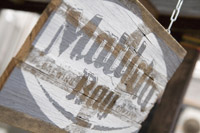
The Matilda Bay portfolio spearheads Carlton’s craft brewing range whilst the Kirin-owned Lion has subsumed Hahn into its broad marketing strategy using the trademark to cover its forays into light, low-carb and midstrength categories. The Hahn brewery itself, in Camperdown NSW, gave birth to Lion’s craft portfolio through the James Squire brand.
The quality and consistency of some of the microbrewers back at the time left a lot to be desired and, while some still talk in hushed tones of Balmain Bock, there wasn’t much in the way of innovation from the market newcomers with the likes of Power’s Brewing choosing to ape the major’s rather bland lager style.
What was different about Hahn and Matilda Bay in the 80s was their willingness to tread comparatively new ground in Australia’s beer landscape. These brewers turned to Europe for their inspiration through Redback, a take on the German Hefeweizen style, and Hahn’s Premium Lager, a classic German Pils. Neither of these beer styles were then represented by local brewers and they were able to stand on their own in the marketplace.
Craft beer has been growing again since the late 90s and there are now more different styles of beer available than ever before. So, where is Australian craft brewing now? What has guided the styling of Australian craft beer and where is it going?
Micro and independent brewers have been bringing the flavours of beer from around the world to local drinkers, delivering the benefit of fresh beer that’s readily available. To date, beer styles have not been plagued with the appellation wars of the wine industry. This gives beer drinkers a good guide of what to expect when purchasing a beer, but at the same time, puts some brakes on innovation.
Looking at big brewers, we see them reproducing classic styles. The James Squire range of beers lists a pilsner, IPA, porter and amber ale, while Matilda Bay offers up a hefeweizen, pilsner, dark lager, and Munich lager. Their collective portfolios are rounded out with , with one exception each, an American style beer.
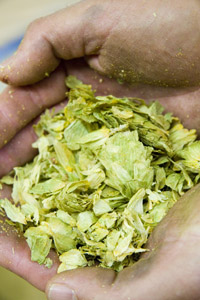 The resurgence of craft brewing this era has been coupled with new styles and flavours. During the latest expansion of microbrewing the American-style Pale Ale has had the biggest influence on craft beer in Australia, if not across the world. It can be put down to one thing – the flavour of Cascade hops.
The resurgence of craft brewing this era has been coupled with new styles and flavours. During the latest expansion of microbrewing the American-style Pale Ale has had the biggest influence on craft beer in Australia, if not across the world. It can be put down to one thing – the flavour of Cascade hops.
US brewers shunned locally-grown hops for decades until a shortfall in the European crop pushed up prices making the US grown hop the only alternative. Cascade, named after the mountain range in Oregon, was meant to be a replacement for these European hops but turned out to be something altogether different with a distinctive citrus aroma and flavour.
The big brewers weren’t exactly happy with the result but the likes of Sierra Nevada turned this unique ingredient into the perfect antidote for the corn-fuelled, low-flavour American lager. Little Creatures brought this flavour to Australians and now there aren’t too many brewers around who don’t have an American-style pale ale in their stable.
The flavour of American hops has not only influenced brewing across the world, but also New Zealand and Australian hop growers over the last decade who have been planting hybrid varieties that share similar characteristic to their American cousins. Some great examples of the contemporary New Zealand hops can be found in Knappstein’s Reserve Lager using Nelson Sauvin to its full.
The American hop is both a blessing and a curse. It’s a great ingredient to give beer some flavour impact but it is arguable that its ubiquity has stifled further creativity.
Do we have a style of beer we can call our own?
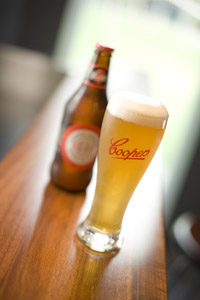 When we talk of beer styles there is only one name that comes to mine when we try and think of an Australian style – Coopers. The sparkling ale is anything but, being cloudy, unfiltered and full bodied with a bready nose and fruity undertones. Coopers stronger red-labelled version and the lighter and slightly sweeter take, the Pale Ale, are the proponents of what is really the only internationally recognised Australian beer style. Coopers has spread its yeasty joy across the country from its native South Australia.
When we talk of beer styles there is only one name that comes to mine when we try and think of an Australian style – Coopers. The sparkling ale is anything but, being cloudy, unfiltered and full bodied with a bready nose and fruity undertones. Coopers stronger red-labelled version and the lighter and slightly sweeter take, the Pale Ale, are the proponents of what is really the only internationally recognised Australian beer style. Coopers has spread its yeasty joy across the country from its native South Australia.
Make no mistake, Coopers is all about the yeast. A unique, powdery strain that disperses well in both bottles and kegs, it is this yeast that gives the beer its unique flavour and appearance. Perversely, the company’s last two recent releases have filtered the good stuff out, showing that what makes a beer unique can also be a handicap to its wider acceptance.
Some other cloudy examples that come to mind are Scharers Lager and Stone & Wood’s Draught Ale. Scharers in another survivor of the 80s, thanks to its strong retail presence in NSW at the Australian Hotel in Sydney and the George the IV in Picton. Geoffery Scharer was a pioneer of the small brewing industry, being the first on-premise brewer awarded a license in Australia.
While Geoff is still occasionally raising hell from retirement, Scharers unfiltered lager is still a staple at both pubs twenty years on. A cloudy lager, whilst unusual in modern brewing, is not exactly a new idea. Kellerbier, or House Beer, is a traditional German, naturally cloudy brew that has existed for centuries.
Kellerbier as a style is making somewhat of a return to fashion with a few brewers making limited releases of unfiltered lagers reproducing a style that Scharers pioneered in Australia.
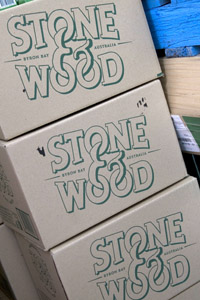 Stone & Wood is a relatively new brewery in Byron Bay with brewing duties headed by Brad Rogers who was at the helm during Matilda Bay’s recent resurgence. Now partly owned by Little World Beverages (Little Creatures), which is in turn partly owned by Lions Nathan, the brewer has focussed on producing a tap beer that tastes the same in the pub as it does from the tank in the brewery.
Stone & Wood is a relatively new brewery in Byron Bay with brewing duties headed by Brad Rogers who was at the helm during Matilda Bay’s recent resurgence. Now partly owned by Little World Beverages (Little Creatures), which is in turn partly owned by Lions Nathan, the brewer has focussed on producing a tap beer that tastes the same in the pub as it does from the tank in the brewery.
By not filtering the product, a lot of the hop flavour and aroma punch remains in the beer. What has made their draught stand out from the pack is the use of Galaxy hops, a relatively new Australian grown variety of the American ilk. What started with the macho bitterness of the Pale Ale brethren has softened with a more subtle hand making this beer stand out as a very drinkable Australian-style drop. It’s popularity has pushed what was going to be a purely keg product into bottles for wider distribution. A good thing for drinkers, but a further confusion in the use of the term “draught”!
So, where to next? Hops have driven the flavour of craft beers for the last decade. Craft brewers have been pushing the boundaries with extreme bitterness but I think it has had its run.
Extreme beers claiming the most hops and the highest levels of bitterness will always be around now, but there is only so far this can go before the beer becomes undrinkable.
The latest trend in American craft brewing has been the Black IPA. Conventional wisdom says that dark malt and loads of hops just won’t work as the acidity of the hops and the acidity of the roasted barley compete ending in something quite unpalatable. However, husk-less dark malt, which eliminates the astringent flavours from roasting, and low cohumolone (the ‘harsh’ bitter component) American hops combine to make something quite special. Check out Murray’s Craft Brewing Company’s “Shawn’s Fault” and Doctors Orders’ Mindwarp for a local examples if you can get your hands on them.
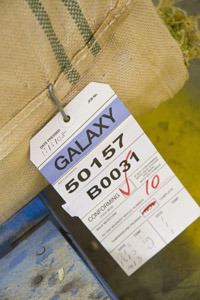 Whilst every brewer enjoys making the weird and wonderful, drinkability has become important again to brewers, perhaps in reaction to the extreme excesses. A lot of craft brewers are finding the more easy-drinking members of their portfolio are the most popular beers with the punters.
Whilst every brewer enjoys making the weird and wonderful, drinkability has become important again to brewers, perhaps in reaction to the extreme excesses. A lot of craft brewers are finding the more easy-drinking members of their portfolio are the most popular beers with the punters.
Both of the major’s craft beer brands have released quaffable lagers. The ‘new world’ pilsner is becoming popular, a style that features generous amounts of New Zealand hops rather than the traditional Czech Saaz variety. Examples of the style include Red Angus from the De Bortoli-owned William Bull Brewery and one from Victoria’s True South Brewery. The use of these hops has created a version of the pilsner style that not found in the Northern Hemisphere.
Other stylistic interpretations include White Rabbit’s white ale, a take on the Belgian Wit without the funky phenolic yeast that has created something quite sessionable. The American-style wheat is also a popular choice with small brewers given its ease of production and approachable character. Murray’s Whale Ale is an example of this style.
More diversity can be found in the rise of the hybrid beer. Both Kolsch and steam beer are ales brewed at lager temperatures, creating a beer that has flavour as well as drinkability. Potters Brewery and Sydney’s 4 Pines have championed the Kolsch style whilst Mountain Goat have had great success with their Steam Beer. Given our warm climate, it makes sense to have these beers on hand to quench the thirst.
This current craft brewing scene is rich with choice and quality. This article only brushes the breadth of Australian craft beer and I would encourage the reader to get out and explore what has been made near you. As brewers strive to produce something unique in the market, there will be even more mining of long-forgotten styles, more hybrid styling and, hopefully, the creation of some brand new beers that break the category book.
Here’s the beer in all its forms.



